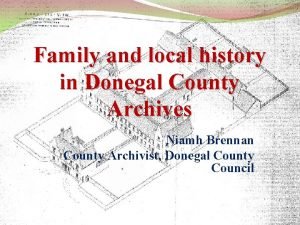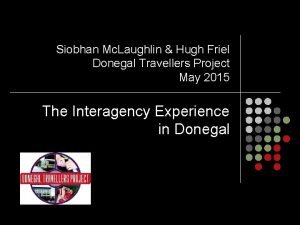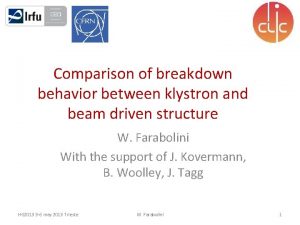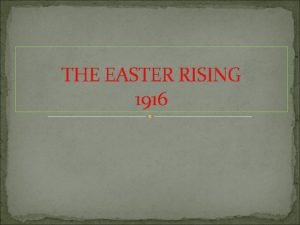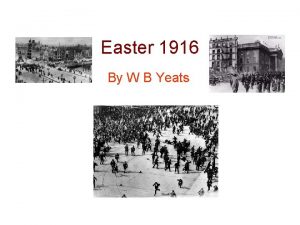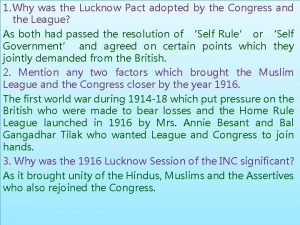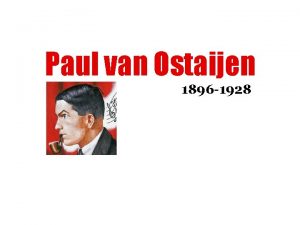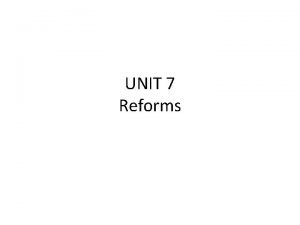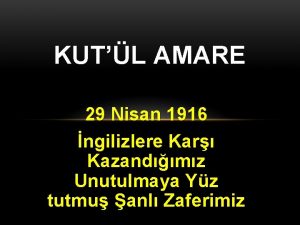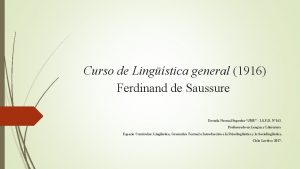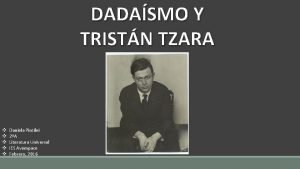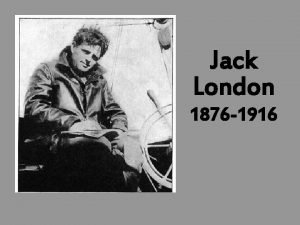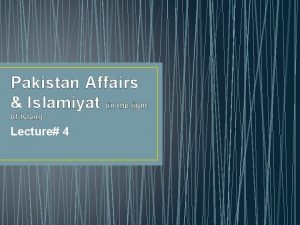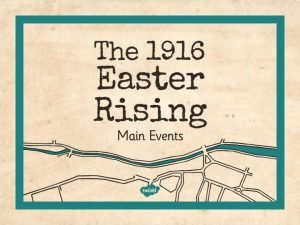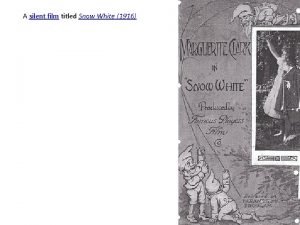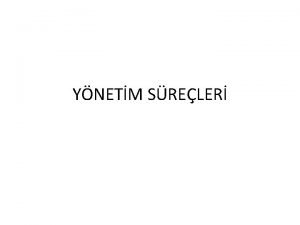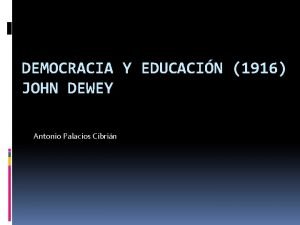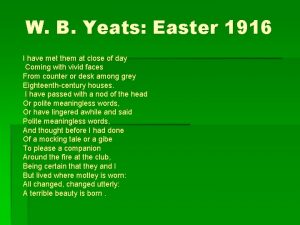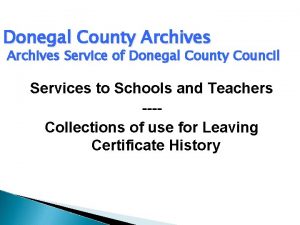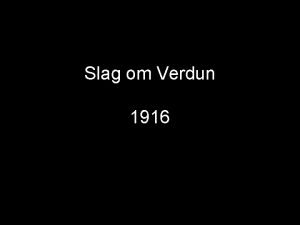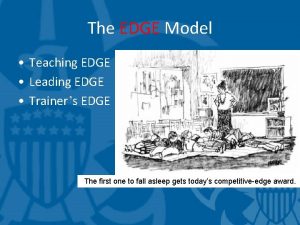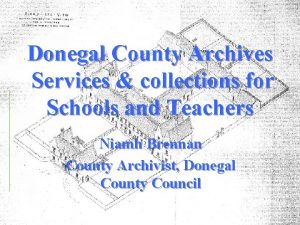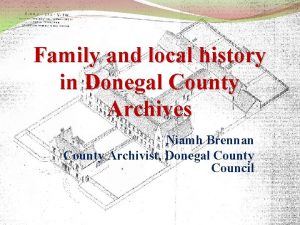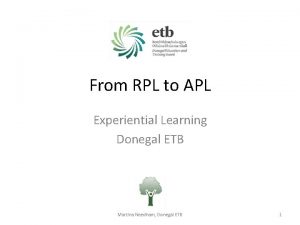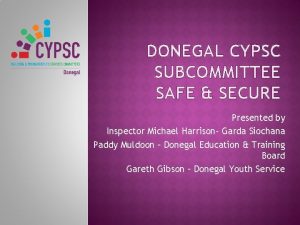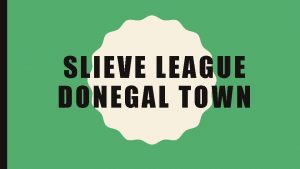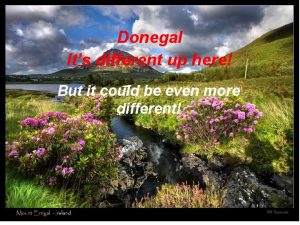From the Edge County Donegal in 1916 A













































- Slides: 45

From the Edge: County Donegal in 1916 � A short history of Donegal in the year of the Easter Rising/middle of World War I

Why County Donegal in 1916? � Decade of Centenaries 1912 – 1923: Commemorations began about 3 or 4 years ago. Period: Home Rule Bill, World War I, advent of Ulster Volunteers and National/ Irish Volunteers; 1916 Rising, 1918 General Election, War of Independence, partition, Civil War; foundation of Free State and Northern Ireland state. � Donegal County Archives has already produced a study pack covering the above period. In time for 1916 Rising centenary we are producing a 1916 heritage and education pack called: From the Edge: County Donegal in 1916.

County Donegal in 1916

County Donegal in 1916 - political situation � Politically only home rule candidates had been elected as Members of Parliament (MPs) in County Donegal since 1885. � In the 1911 local elections, 26 of the 32 seats had been won by home rule candidates. � Unionists resisted the Third Home Rule Bill. This opposition led to the formation of the Ulster Volunteers which in turn resulted in the formation of the nationalist Irish Volunteers in 1913.

County Donegal in 1916 - political situation � The Volunteer movement grew in Donegal and elsewhere in 1913 - 1914. � The Home Rule Act was suspended with outbreak of War in August 1914. With nationalist opinion divided over the war, the Volunteer movement split. � Following the split and an intensified recruitment campaign by the British Army, the Volunteer movement declined in 1915. � Membership of the Irish Volunteers would increase again only after the Easter Rising in 1916.

County Donegal in 1916 – on the land

Life in County Donegal– on the land � In 1916 County Donegal was a rural, farming community. Population: approximately 168, 000. � Housing was basic; no electricity or running water; there was an open fire in main room. 50% living in houses of two rooms. � There were improvements in living conditions due to local authorities providing better housing, sewerage, water supplies; Congested Districts Board schemes included pier and harbour building, financially assisting local enterprises, fishing & agricultural development, railway development.

Life in County Donegal-on the land � Growth of co-operatives and creameries i. e. Templecrone (the Cope) in Dungloe was 10 years old in 1916. � Rural and town accommodation was improving by 1916, with ‘labourers’ and ‘housing of the working classes’ cottage schemes but inspectors’ reports on the living conditions of labourers revealed extent of grinding poverty still in existence. Little building by 1916 due to war. � Overall in Co Donegal, poor remote farming communities were the majority. Small subsistence farms in the west of the county, larger farms in the east.

Life in County Donegal –on the land

Life in County Donegal –on the land � Much land was still owned by large landowning families in 1916, transference of land to small farmers under Land Acts had been interrupted by World War I (due to cost, lack of labour etc). � Seasonal migration by workers from west Donegal to farms in the Laggan was in decline by 1916 but another important seasonal migrant route to Scotland had been established. � Thousands of men had joined the British forces fighting World War I.

Life in County Donegal- on the land � Entertainment usually in the home, involved family, friends and neighbours exchanging stories and songs, sharing news, playing music together in the home; fair days.

Life in County Donegal– Farming

Life in County Donegal- Farming � In early 20 th century, the long tradition of arable farming had declined throughout Ireland including Donegal, and livestock farming, particularly of sheep, was on the rise. � Tillage was encouraged during World War I. During the summer of 1916, there were fierce storms across county, low temperatures and heavy rain. � The combination of this, the labour shortage and the wet ground, caused many of the potatoes to rot. � The result was increased prices and a shortage of potatoes. This also affected the seed crop for sowing the following year. � Main beneficiaries of rising prices were the wealthier farmers. �

Life in County Donegal- Fishing � � � Fishing under threat even before War due to large steam drifters operating from Scotland; Instead Donegal fishermen used smaller Greencastle yawls. Neighbours often shared boats. Fishermen had to sell produce in smaller quantities, and to support the larger industry with jobs such as packing, gutting, curing and carting.

Life in County Donegal- Fishing � With the onset of war, the steam drifters were requisitioned by the Admiralty. � Fishing was banned along the west Donegal coast and mines were laid in the waters around Donegal. � The Congested Districts Board had planned to invest in the fishing industry in Co Donegal- war curtailed this. � People involved in fishing including the ancillary industries were left jobless.

Life in County Donegal -Fishing � Local men continued to fish inshore, away from the mines, and gradually local businessmen filled the void left by the Scottish steam drifters. � Herring was plentiful in 1916/1917 and prices rose. Railways helped transport of fish to market. � Unstable employment opportunities in fishing and farming usually led to migration but this had virtually stopped by 1916 as conscription and resulting recruitment to the British Army intensified in Scotland.

Life in County Donegal- children

Life in County Donegal- Children � Unemployment led to increase in children being hired out to the more fertile farms of the Laggan in east Donegal. � Some teenagers even sent to Scotland as ‘tattie hokers’ from 1915 to 1918. � Education Commissioners stated that 70 percent of children attended school regularly in 1916. � Teachers in Donegal despaired that children would ever receive a decent education.

Life in County Donegal- Children � In 1916 rural schoolhouses in County Donegal usually had one room. � Children often had to collect firewood and turf from the locality to keep their building warm in winter. � Children were frequently absent from school to help at home & on farm, particularly during harvesting. � Children often attended school in bare feet and inadequate clothing; absences due to illness were also frequent.

Life in County Donegal- Children � From the timetable you see here, a surprising variety of subjects taught. � Drawing, singing as well as maths, reading, writing, history and geography.

Life in County Donegal - Children � Extra subjects for girls: laundry, cooking, needlework. � Timetable doesn’t include religion but presumably clergy came to teach doctrinal subjects. � Irish was not taught in Donegal schools in 1916 except in some schools as an ‘extra subject. ’

Life in County Donegal- Women

Life in County Donegal- Women � Women worked at home, and also outside on farms, sold produce; particularly during the War. � Cottage industries included knitters, weavers, embroiderers and lace makers. � Some younger women migrated as tattie hokers to Scotland. � Many worked in fishing industry, ‘gutters’, packers etc. � They also worked as teachers, domestic servants, shop assistants, typists. � Mortons carpet factory at Killybegs.

Life in County Donegal- Women � During World War I, women knitted supplies for war. � In rural Donegal women gathered sphagnum moss for surgical dressings which were in huge demand. � Served as nurses at the Front: e. g. Catherine Black from Ramelton: “at night, the cheerful ward became a place of torment, with the occupants of every bed tossing and turning and moaning in the hell of memories let loose”.

Life in County Donegal- Women Catherine Black from Ramelton, Co Donegal

Life in County Donegal- Women � Irish Women’s Franchise League was established in 1908 to campaign for the right to vote. By 1916, although female property owners could vote and stand for all local elections, women could not vote or stand in general elections. � Women involved in Cumann na m. Ban included Eithne Coyle- (War of Independence). � Women League. were involved in Gaelic cultural revival, Gaelic

County Donegal: Poverty & Health

Poverty & Health- Workhouses � Eight workhouses: Ballyshannon, Donegal, Carndonagh, Dunfanaghy, Glenties, Stranorlar, Letterkenny, Milford. � People, young and old, homeless, destitute or ill and incapable, were still frequently forced into workhouses. � Diseases that are now mainly gone still existed in 1916: e. g. : measles, diphtheria, typhoid, typhus fever, scarlatina, enteric fever, whooping cough, tuberculosis and virulent strains of influenza. Fever hospitals at local workhouses attended to sick. � Orphaned children were ‘boarded out’ from workhouse.

Poverty & Health- Workhouses � Ballyshannon Fever Hospital tended to sick and injured soldiers whose base was the nearby Finner Camp. � In 1916 the hospital tended to 37 soldiers of the twelfth battalion of the Royal Inniskilling Fusiliers. � The average cost of an inmate for a week in Dunfanaghy workhouse in 1916 was five shillings and 8 and a half pence, for taking care of the patients in the infirmary it was six shillings and five pence.

Poverty & Health- Workhouses Ballyshannon Fever Hospital 1916 with Army personnel patients.

Poverty & Health- Mental health � In 1916, 134 people were admitted to Donegal District Lunatic Asylum (St Conal’s). Of those, 86 were men and 48 women. The youngest in 1916 was a 13 year old boy and the oldest was a 77 year old man.

Poverty & Health – Mental health � St Conal’s 1916 patients: � Included were shop assistants, labourers, farmers, housekeepers, clerks, domestic servants, dealers and shoemakers, a policeman, a church verger, a solicitor, a hawker, a flax scutcher, a soldier, a sailor and an exsoldier, a ‘lady of means’. � Only one man admitted in 1916 was a serving soldier, aged 21, sent there by the British Army from Dykebar War Hospital in Paisley. A casualty of war, he was stated to be suffering from depression due to ‘stress of campaign. ’ He was discharged in 1917.

The Easter Rising 1916

The Easter Rising 1916 � � � Began Easter Monday 24 April. During Easter Week the rebels occupied key buildings in Dublin including the GPO, the Four Courts, the South Dublin Union, Boland’s Mill, Stephen’s Green and Jacob’s Biscuit Factory, but crucially Dublin Castle was not held. On Tuesday, martial law was declared, and 16, 000 British troops arrived from Belfast, the Curragh and from England. Tanks and a naval gunboat, the Helga, were used in the city centre to suppress the rising. 485 men, women and children were killed during or as a direct result of the Easter Rising. Of these casualties, 184 civilians, 107 British soldiers, 58 rebels and 13 members of the police forces were killed between 24 and 29 April 1916.

The 1916 Rising- what happened in Donegal � As we’ve seen the effect of World War I was visible everywhere in County Donegal. But the Rising? � Though it began on Easter Monday 24 April 1916, news of the events only reach Donegal on Friday.

Donegal & The Rising: participants � � � Main player from Donegal: Joseph Sweeney, who later became youngest Dáil member, and Chief of Staff of Irish army. Pupil of Patrick Pease at St Enda’s in 1916 (also UCD student); making munitions prior to Rising. He fought in the GPO – ‘engaged for the most part in sniping’ and later wrote of his experiences. He was a stretcher bearer for James Connolly. Supported Treaty.

Donegal & The Rising: Joseph Sweeney

Donegal & The Rising: participants in Dublin � Joseph Sweeney, and two Mc. Ginley brothers Eunan and Conor spent time in British prisons after Rising. � When they came home they set about recruiting Irish Volunteers in preparation for the War of Independence. � Daniel Kelly based in Cashelnagore, Gortahork, had organised IRB and Volunteers. � Tried to get to Dublin to fight during Easter Week, no trains. Arrested and sent to gaol in Britain. Out later that year.

Donegal & The Rising: participants in Dublin Irish prisoners in Stafford gaol including Joseph Sweeney, Eunan Mc. Ginley and Michael Collins.

Donegal & The Rising: Daniel Kelly

Donegal & The Rising: Charles Mc. Gee from Inishbofin, was a Constable in the Royal Irish Constabulary. He was based in Castlebellingham in County Louth. On the morning of 24 April 1916, Volunteers from Dundalk Louth raided the RIC barracks in Castlebellingham and Mc. Gee was shot dead, an army officer wounded.

Donegal & The Rising: Charles Mc. Gee � Const Mc. Gee’s Headstone in Gortahork: R. I. P. Sacred to the memory of Constable Charles Mc. Gee who died on 24 th April 1916 from wounds received whilst gallantly doing his duty as a member of the Royal Irish Constabulary — Erected by his sorrowing parents and by the subscribers of the Irish Police and Constabulary Recognition Fund.

The 1916 Rising- Reaction in Donegal � Friday of Easter Week before information filtered through of the Dublin events. � Negative reaction in On the motion of Cllr Diver seconded Donegal initially by Cllr Denis Doherty it was resolved we deeply deplore and strongly expressed by media that condemn the action of the Sinn Fein & politicians. leaders in causing wanton destruction to life and property in Dublin and elsewhere (Inishowen RDC).

The 1916 Rising- Reaction in Donegal � As martial law was implemented and leaders were shot and imprisoned many changed their minds and support for independence grew. � Membership of Volunteers grew again and antipathy to World War I grew. That we the members of the Donegal RDC protest against the continuance of martial law in this county….

The 1916 Rising- Reaction in Donegal � Prisoners released and welcomed across Donegal. � Many unionists in Donegal were not happy – feared for their future in a divided Ireland. The resolution…that the time has arrived for the Irish nation to unanimously demand the release of her fellow countrymen who have been interned in English prisons…was unanimously approved…. (Dunfanaghy RDC)
 Donegal broadband
Donegal broadband Falmore house gleneely
Falmore house gleneely Donegal town population
Donegal town population Friel
Friel Rising edge and falling edge
Rising edge and falling edge Easter sunday 1916
Easter sunday 1916 September 1916 yeats
September 1916 yeats Mention the significance of the lucknow pact of 1916
Mention the significance of the lucknow pact of 1916 Oscar jespers
Oscar jespers Lakhnao pact
Lakhnao pact 29 nisan 1916
29 nisan 1916 Saussure 1916
Saussure 1916 Biografia de tristan tzara
Biografia de tristan tzara John griffith london
John griffith london Objectives of khilafat movement
Objectives of khilafat movement Main events of 1916 rising
Main events of 1916 rising Snow white silent film
Snow white silent film çapraz eşgüdümleme nedir
çapraz eşgüdümleme nedir Surrealismo 1920
Surrealismo 1920 Dewey 1916
Dewey 1916 Từ cuối năm 1916 đức áo thun
Từ cuối năm 1916 đức áo thun I have met them at close of day
I have met them at close of day Tư thế ngồi viết
Tư thế ngồi viết Thẻ vin
Thẻ vin Thơ thất ngôn tứ tuyệt đường luật
Thơ thất ngôn tứ tuyệt đường luật Chúa sống lại
Chúa sống lại Các châu lục và đại dương trên thế giới
Các châu lục và đại dương trên thế giới Từ ngữ thể hiện lòng nhân hậu
Từ ngữ thể hiện lòng nhân hậu Sự nuôi và dạy con của hổ
Sự nuôi và dạy con của hổ Diễn thế sinh thái là
Diễn thế sinh thái là Vẽ hình chiếu vuông góc của vật thể sau
Vẽ hình chiếu vuông góc của vật thể sau V. c c
V. c c Phép trừ bù
Phép trừ bù Tỉ lệ cơ thể trẻ em
Tỉ lệ cơ thể trẻ em Lời thề hippocrates
Lời thề hippocrates đại từ thay thế
đại từ thay thế Quá trình desamine hóa có thể tạo ra
Quá trình desamine hóa có thể tạo ra Công của trọng lực
Công của trọng lực Môn thể thao bắt đầu bằng chữ f
Môn thể thao bắt đầu bằng chữ f Thế nào là mạng điện lắp đặt kiểu nổi
Thế nào là mạng điện lắp đặt kiểu nổi Hình ảnh bộ gõ cơ thể búng tay
Hình ảnh bộ gõ cơ thể búng tay Dạng đột biến một nhiễm là
Dạng đột biến một nhiễm là Vẽ hình chiếu đứng bằng cạnh của vật thể
Vẽ hình chiếu đứng bằng cạnh của vật thể Nguyên nhân của sự mỏi cơ sinh 8
Nguyên nhân của sự mỏi cơ sinh 8 Phản ứng thế ankan
Phản ứng thế ankan Voi kéo gỗ như thế nào
Voi kéo gỗ như thế nào

